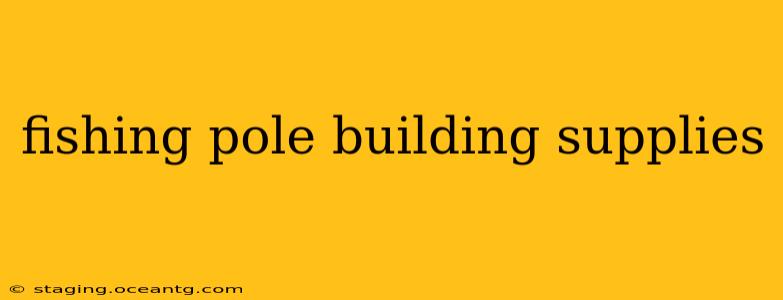Building your own fishing rod is a rewarding experience, allowing you to tailor the perfect tool to your specific fishing style and preferences. From delicate fly rods to powerful surf casting rods, the possibilities are endless. But before you begin, you need the right fishing pole building supplies. This comprehensive guide will walk you through the essential materials and components, helping you assemble everything you need for a successful build.
What are the basic fishing pole building supplies?
The core components of a fishing rod are surprisingly simple, yet the quality and selection of these components significantly impact the rod's performance and longevity. The basic building blocks include:
-
Rod Blanks: These are the pre-formed carbon fiber or fiberglass tubes that form the backbone of your rod. Choosing the right blank is crucial, as it determines the rod's action, power, and length. Consider the type of fishing you'll be doing (bass fishing, fly fishing, saltwater fishing, etc.) when selecting a blank. Different blanks are designed for specific techniques and target species.
-
Guides: These are the rings through which your fishing line passes. Guides are crucial for smooth casting and preventing line friction. They come in various materials (stainless steel, ceramic, titanium) and sizes, each with its own advantages and disadvantages. Consider the type of line you'll be using when selecting guides.
-
Reel Seat: This is the part of the rod that holds your fishing reel securely. Reel seats come in various styles (screw-down, sliding band) and materials (graphite, aluminum, etc.). Choose a reel seat that's compatible with your chosen reel and provides a secure fit.
-
Handle Components: This includes the cork, EVA foam, or other materials used to create the grip of the rod. The handle should be comfortable and provide a secure grip, even when wet. Consider the size and shape of your hand when selecting handle components.
-
Epoxy Resin and Hardener: This is essential for bonding the various components of the rod together. High-quality epoxy is crucial for creating a strong, durable, and long-lasting rod.
-
Sandpaper and Finishing Supplies: You'll need sandpaper to smooth the rod blank and handle components before applying the finish. Finishing supplies might include paints, stains, or clear coats to protect and enhance the appearance of your finished rod.
What type of epoxy is best for building fishing rods?
Choosing the right epoxy is critical. A slow-curing, high-quality epoxy designed for rod building is essential for a strong and durable bond. Fast-curing epoxies can be more difficult to work with and may not provide as strong a bond. Look for epoxies specifically formulated for rod building applications.
What tools do I need to build a fishing rod?
In addition to the materials listed above, you will also need various tools, including:
- Rod Building Guides: These are tools to help you evenly space and install the guides along the rod blank.
- Sandpaper (various grits): For smoothing and preparing surfaces for finishing.
- Epoxy Mixing Cups and Sticks: For precise mixing of your epoxy resin and hardener.
- Measuring Tape: For accurate measurements during the building process.
- Heat Gun (optional): For accelerating the curing process of the epoxy.
What kind of fishing rod blank should I use?
The type of rod blank you choose depends entirely on the type of fishing you plan to do. A fly fishing rod blank will be very different from a bass fishing rod blank or a saltwater rod blank. Consider factors like:
- Action: Fast, moderate, or slow action refers to how the rod bends under load.
- Power: Light, medium, heavy, extra-heavy refers to the rod's ability to handle different weights of lures and fish.
- Length: This depends on the type of fishing you'll be doing.
Consult with a rod building expert or do extensive research before selecting your blank.
How much does it cost to build a fishing rod?
The cost of building a fishing rod varies greatly depending on the quality of the components you choose. You can build a functional rod for a reasonable price, but using higher-end components will naturally increase the overall cost.
This comprehensive guide provides a solid foundation for your fishing rod building journey. Remember, patience and attention to detail are key to creating a high-quality, custom-built rod. Happy building!
